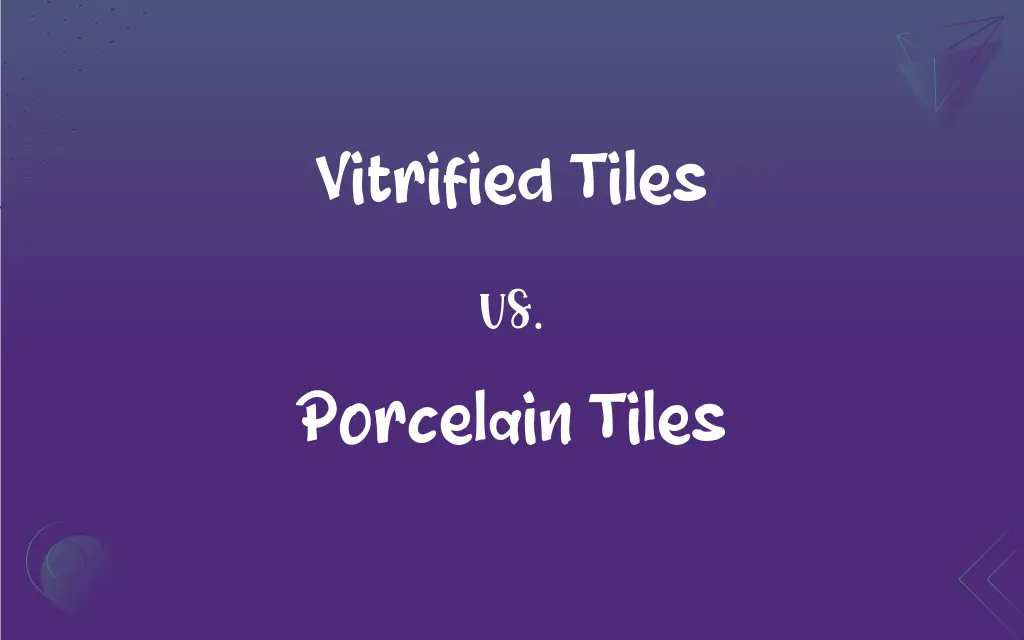Vitrified Tiles vs. Porcelain Tiles: What's the Difference?
Edited by Janet White || By Harlon Moss || Updated on October 19, 2023
Vitrified tiles are ceramic tiles with low porosity due to vitrification, while porcelain tiles are a type of vitrified tile known for its high density and durability.

Key Differences
Vitrified tiles are ceramic tiles that undergo a process called vitrification, resulting in a glass-like texture and reduced porosity. Porcelain tiles, on the other hand, are a subtype of vitrified tiles that are specifically made from porcelain clay, leading to a denser and more durable tile.
The manufacturing process of vitrified tiles involves exposing them to high temperatures, which fuses the tile particles together and makes them less porous. Porcelain tiles are also fired at high temperatures, but due to the finer clay particles used, they attain an even higher density, making them particularly robust.
Vitrified tiles are versatile and come in various types, including full-body, glazed, and double-charged. Porcelain tiles, however, are renowned for their consistent composition throughout the tile's body, which ensures minimal wear and a longer life, especially in high-traffic areas.
One notable feature of vitrified tiles is their resistance to water absorption, making them an ideal choice for areas prone to moisture, like bathrooms and kitchens. Porcelain tiles, being a type of vitrified tile, inherit this quality but offer an even greater resistance due to their dense nature.
When it comes to aesthetics, both vitrified tiles and porcelain tiles offer a plethora of design options, but porcelain tiles often boast a more natural and authentic finish, mimicking natural stone or wood patterns with impressive accuracy.
ADVERTISEMENT
Comparison Chart
Composition
Ceramic tiles with low porosity.
A type of vitrified tile made from porcelain clay.
Manufacturing Process
Exposed to high temperatures for vitrification.
Fired at high temperatures with finer clay particles.
Types
Full-body, glazed, double-charged, etc.
Consistent composition throughout.
Durability
Durable with reduced porosity.
Highly durable with minimal wear.
Aesthetic Options
Versatile designs and patterns.
Often mimics natural patterns like stone or wood.
ADVERTISEMENT
Vitrified Tiles and Porcelain Tiles Definitions
Vitrified Tiles
Durable tiles ideal for moisture-prone areas.
The kitchen's vitrified tiles have held up well against spills and stains.
Porcelain Tiles
A type of vitrified tile with consistent composition.
Porcelain tiles in the cafe gave a natural stone-like appearance.
Vitrified Tiles
Ceramic tiles made less porous through vitrification.
We chose vitrified tiles for the bathroom due to their water resistance.
Porcelain Tiles
Flooring option that mimics natural patterns.
The wood-patterned porcelain tiles added warmth to the room.
Vitrified Tiles
Flooring materials with a glass-like finish.
The sheen on the vitrified tiles added a touch of luxury to the living room.
Porcelain Tiles
Highly durable tiles made from porcelain clay.
The hallway's porcelain tiles resisted wear even with heavy foot traffic.
Vitrified Tiles
Tiles that undergo a high-temperature treatment for enhanced properties.
Vitrified tiles in the lobby looked as pristine as when they were first installed.
Porcelain Tiles
Tiles known for their high density and robustness.
We opted for porcelain tiles in the commercial space due to their longevity.
Vitrified Tiles
Tiles known for their reduced water absorption rate.
Vitrified tiles ensured the poolside remained slip-resistant.
Porcelain Tiles
Tiles resistant to moisture, stains, and wear.
The outdoor porch, adorned with porcelain tiles, remained in excellent condition through seasons.
FAQs
How are porcelain tiles different from other vitrified tiles?
Porcelain tiles are a subtype of vitrified tiles made from porcelain clay, making them denser and more durable.
Are vitrified tiles durable?
Yes, vitrified tiles are durable, especially due to their reduced porosity.
Is the manufacturing process different for vitrified and porcelain tiles?
Both are exposed to high temperatures, but porcelain tiles use finer clay particles, achieving a higher density.
What are vitrified tiles?
Vitrified tiles are ceramic tiles made less porous through a process called vitrification.
Do porcelain tiles mimic natural materials?
Yes, porcelain tiles often replicate natural patterns like stone or wood with high accuracy.
Can vitrified tiles be used outdoors?
Yes, vitrified tiles can be used outdoors, especially since they resist moisture well.
Are vitrified tiles resistant to moisture?
Yes, vitrified tiles have a low porosity, making them resistant to moisture.
How do porcelain tiles fare against chips and cracks?
Due to their high density and durability, porcelain tiles resist chips and cracks effectively.
Which tile is better for high-traffic areas?
Porcelain tiles, due to their high density and durability, are ideal for high-traffic areas.
Do vitrified tiles have a glossy finish?
Vitrified tiles can have a glossy, glass-like finish, but other finishes are available too.
Are vitrified tiles stain-resistant?
Vitrified tiles resist stains well because of their low porosity.
Can I use vitrified tiles for my kitchen?
Yes, vitrified tiles are suitable for kitchens as they resist moisture and stains.
What's the lifespan of porcelain tiles compared to other flooring options?
Porcelain tiles, due to their robust nature, often have a longer lifespan than many other flooring materials.
Are porcelain tiles a type of ceramic tile?
Yes, porcelain tiles are a type of ceramic tile, specifically made from porcelain clay.
Which tiles offer more design options?
Both vitrified and porcelain tiles offer a wide range of design options, but porcelain often has more natural-looking finishes.
Are porcelain tiles expensive?
Porcelain tiles can be pricier than some other tiles due to their quality and durability.
How are vitrified tiles made less porous?
They undergo a high-temperature process called vitrification that reduces porosity.
Can porcelain tiles be used in bathrooms?
Yes, porcelain tiles are ideal for bathrooms due to their moisture resistance.
How do porcelain tiles compare in terms of maintenance?
Porcelain tiles require minimal maintenance due to their durability and resistance to staining.
Are vitrified tiles environmentally friendly?
Vitrified tiles are generally eco-friendly, especially if sourced from manufacturers who follow sustainable practices.
About Author
Written by
Harlon MossHarlon is a seasoned quality moderator and accomplished content writer for Difference Wiki. An alumnus of the prestigious University of California, he earned his degree in Computer Science. Leveraging his academic background, Harlon brings a meticulous and informed perspective to his work, ensuring content accuracy and excellence.
Edited by
Janet WhiteJanet White has been an esteemed writer and blogger for Difference Wiki. Holding a Master's degree in Science and Medical Journalism from the prestigious Boston University, she has consistently demonstrated her expertise and passion for her field. When she's not immersed in her work, Janet relishes her time exercising, delving into a good book, and cherishing moments with friends and family.































































